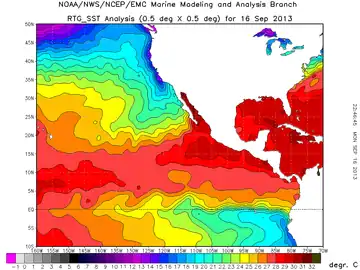
Diathermancy (from "dia" through and "thermē" heat) is the property of some fluids that allows rays of light through them without itself being heated. A diathermanous substance is thus "permeable" by heat.[1] Diathermancy was first described by German physicist and chemist Heinrich Gustav Magnus in the 1800s.[2]
Air is diathermanous; therefore atmospheric air is not heated by sunshine. Atmospheric air is heated by long-wave thermal radiation emitted by soil, and especially, by water on the Earth's surface.
Water is not diathermanous, and it is heated directly by sunshine.
Atmospheric heating from oceanic waters

Atmospheric heat comes from long-wave radiation from the soil and, mostly, from the water surface (oceans, lakes, rivers), because water is a not diathermanous body and covers three quarters of Earth's surface. Diathermancy cause subsidence above damp or water surfaces. That is because these areas tend to absorb heat radiation directly from the Sun but very slowly and also emit this radiation to the atmosphere very slowly. Therefore, cold ocean currents have very clear skies, without clouds, because subsidence from cold and heavy air avoids or limits convection because they are opposite processes.
See also
References
- ↑ Diathermanous, Fine Dictionary
- ↑ Magnus wrote initially four papers on Diathermancy
External links
 Media related to Diathermancy at Wikimedia Commons
Media related to Diathermancy at Wikimedia Commons